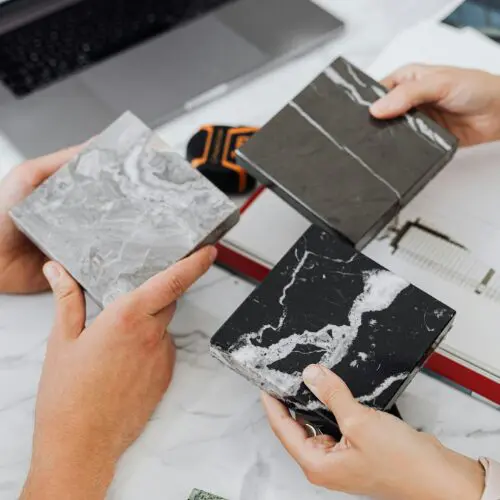
Lessons From a Contractor’s Wife – Part 4
Hi, I’m Sarah! I’m the wife of Lucas Casper, the owner of Casper Builders. Usually, I stay happily on the sidelines of the business, but when Lucas and I decided to build our own house this year, I suddenly found myself wearing many hats: part-time designer, part-time laborer, part-time project manager, and full-time “gofer.”

In this blog series, I’m going to share what building a custom home looks like from the non-professional’s perspective—the surprises, the lessons learned, and all the little details that no one tells you about until you’re in the thick of it. Come see how the sausage is made!
Part 4: Decision Fatigue and the Great Green Tile Debate
Now for the fun part—picking out tiles, flooring, and paint colors! Except… not so fast.
Did you have any idea how many tile options exist in the world? We’re talking porcelain, ceramic, glass, natural stone, and about thirty-seven subcategories I didn’t know existed. And flooring? Wood, engineered wood, carpet, laminate, LVP, LVT, … the list goes on.

But let’s talk about colors for a moment, because this is where things got really interesting in our partially-constructed house.
I was browsing backsplash tiles for our kitchen and some I loved that incorporated a shade of green I saw on Pinterest. Lucas agreed it looked good. Simple, right?
“Okay, but what type of green?” I asked.
“The dark one,” he said.
“But there are ten different dark ones. Do you like the forest green or the sage? Or maybe something in the olive family…?”
Lucas looked at me like I was speaking another language. To him, they all looked the same (and to be fair, he probably doesn’t care nearly as much about the backsplash as I do).

Turns out, there’s actual science behind this. Researchers at CUNY’s Brooklyn College conducted color perception experiments and discovered that men and women literally see colors differently. Women tend to be significantly more perceptive when it comes to distinguishing between color shades, while men struggle particularly with differences in greens, blues, and yellows. Even more fascinating: specific colors can appear stronger or weaker depending on who’s looking at them. Orange actually appears redder to men, while women perceive yellows and yellow-greens as being greener.
So when Lucas said all those tiles looked the same, he genuinely meant it. His brain was processing them differently than mine.
But I digress…
When you’re making dozens of design decisions every week, watching your construction loan balance climb higher and higher, every single choice starts to feel monumental. You’re not just picking a paint color—you’re choosing something you’ll have to live with for years, something that represents a significant chunk of money. The weight of all those decisions piles up fast.
We’ve found a few strategies to combat this overwhelming feeling. First, we are painting all our walls white. Just white. For now. If we want to add color later, we can tackle it one room at a time when we’re not simultaneously choosing twenty other things. In fact, most of our design scheme leans neutral, giving us the flexibility to change things down the road without starting from scratch.
LESSON: Spend your decision-making energy on the expensive, hard-to-change stuff.
Really think through the color and species of your wood for doors, trim, and cabinets—refinishing those later is both expensive and incredibly annoying (trust me, I’ve done it). If you’re going with quartz or similar countertops, choose something versatile enough to work with multiple design styles. When in doubt, stick to neutrals for the big-ticket items.
The beauty of neutrals is that fixtures, faucets, cabinet hardware, and paint are all relatively easy and inexpensive to swap out later. These are your opportunities to inject personality and style without committing tens of thousands of dollars to a trend that might not age well. Think of your permanent choices as the foundation and your changeable elements as the accessories. You wouldn’t buy a coat you could never take off, right? Same principle.
By keeping our base neutral and our options open, we’ve given ourselves permission to evolve our style over time—and more importantly, we’ve saved our sanity during a process that already requires about a million other decisions. Future us will thank present us when we’re not staring at avocado green tile wondering what we were thinking in 2025.
